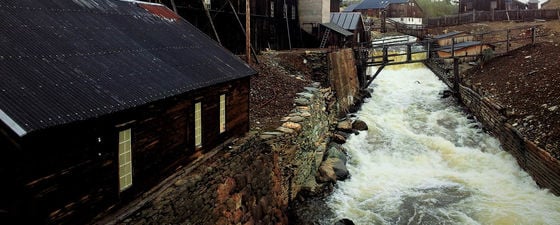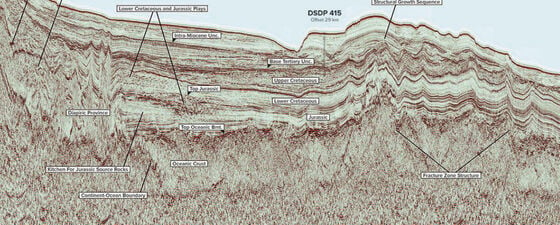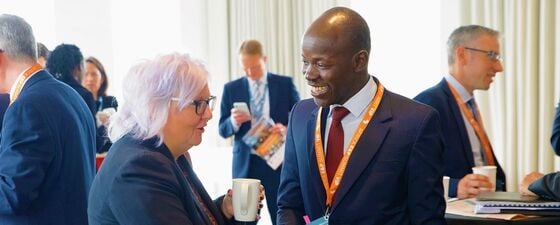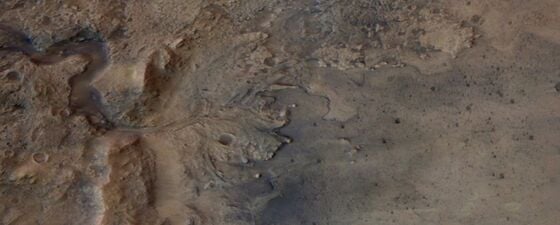Røros, a small, charming town on the mountain plain in central Norway, is best known for its mining history, picturesque old wooden buildings and its place on UNESCO’s World Heritage list. But it is the atmosphere that make Røros a cultural gem.
Top left: Map of Norway showing location of Røros. © Google Maps. Main map: Map of central Norway, with the location of the UNESCO World Heritage Røros Mining Town.
Biting cold winds and flurries of snow have followed the sleigh-riders for days. Here, up in the Scandinavian mountains, farmers from central Sweden are on their way westwards to the Norwegian mining town of Røros, many days travel with horses and sledges. In northern Scandinavia February days are short, and the row of torches carried by the riders can be seen for many kilometres in the dark, snow-covered winterland. A scene from 200 years ago – and from February 2020.
Few places in Norway are more beautiful than Røros in winter. And during the annual winter market, Rørosmartnan, the historic city is transformed into a popular party.
Mining in Røros Copper Works began in 1644 and winter transportation routes started two years later, granted by a Royal Charter from the King in Copenhagen. The Winter Road, with horse-drawn sledges pulled over ice-covered rivers, lakes and marshlands, was one of the busiest transportation routes between Sweden and Røros, used from November until spring in early May. The traffic was ended when railways and cars took over from horses, but resumed in 1981. Last year about 80 horse-drawn cargoes travelled the 194 km from Särna in Sweden to join the opening ceremony of the Rørosmartnan in late February.
The town of Røros is built almost entirely of wood, and contains around 2,000 wooden houses, a smelting house and Bergstadens Ziir (Røros Church). Bergstaden means ‘the mining town’. © Morten Smelror.
Røros Church (Bergstaden Ziir) was built in 1784 and is regarded as one of the most important churches in Norway. Røros Copper Works paid for the building of the stone church, and the symbol of the Copper Works was put on all sides of the tower wall. © Morten Smelror.
Røros Copper Works: 333 Years of Copper Mining
From the mid 1600s, ore from the mines became the foundation for Røros Copper Works and for the town. During the 333 years of operations, there were more than 40 copper mines and over 200 chrome mines and quarries in the areas around Røros, meaning that for much of its history, Røros Copper Works was among Norway’s most important mines. Copper, zinc, chrome and pyrites were all extracted from the area, with between 1644 and 1977, around 110.000 tons of copper and 525.000 tons of sulphur pyrite being produced. The most productive mines were situated in the area around Storwatz and Nordgruvene, located some 10 to 12 km north-east of the town of Røros. At Storwartz traces of copper was first discovered by a local reindeer hunter – reindeer are still a common sight in the area today. Several copper mines were opened around Storwartz during the 1600s, and the mining at Nordgruvene started in 1657. During the second half of the 1800s pyrite was the main type of ore extracted here.
Mining was always hard work. During the 1600 and 1700s much of the work was carried out by hand tools and human muscles. The first 100 years the ore was extracted by heating the rock with wood fires. Later, a shortage of wood led to the use of explosives. Sledge-hammers, chisels and long crowbars where used to make holes which were filled with gunpowder and sealed off with clay or wooden plugs, before the fuse was lit. Later, electricity, dynamite and compressed-air power tools made the operations easier, less labour-intensive and safer. However, dust, carbon and sulphurous gases and a lack of fresh air were major challenges to health and environment throughout the hundreds of years of mining.
According to local history, most of the copper from Røros was used to cover roofs on churches in Copenhagen and to produce weapons. Recent studies, however, have proved that between 80% and 90% of the metal was shipped from Trondheim to Amsterdam. During the 1700s, from early spring until late autumn, there was a nearly constant stream of Norwegian ships sailing between the cities, although in winter the Trondheimsfjord was ice-covered, frozen and closed to ships. For those of us who have lived by the fjord for decades and never seen any ice in the mid and outer fjord areas, this sounds a bit strange, but we should remember, that this was during the Little Ice Age, which lasted from around 1400 to mid-1800. The coldest period in the Nordic countries was around 1740. At that time, the glaciers expanded, summers were short, crops failed and people were starving and suffering.
Røros has kept its medieval appearance, and alongside the old wooden houses, a timber canals runs through the city centre. © Morten Smelror.
The Storwatz mine is 12 km north-east of Røros Town. Here traces of copper were first discovered by a local reindeer hunter, and mining started in 1654. © Morten Smelror.
Amsterdam was a major port and trade centre. However, the copper from Røros had to be refined before it could be used in various products. Knowledge of refining copper was restricted, and most of the copper from Røros was transported from Amsterdam to Stolberg, today a part of Aachen in Germany, where much of the ore was processed into brass plates and wires.
A Mining Town Heritage
The UNESCO World Heritage Røros Mining Town and the Circumference, an area within 45 km radius around the town, comprise three main sites: Røros Town itself and surrounding historical areas and buildings; the Femund Hut; and the Winter Road, which is the route used in the winter for transportation of goods through Tufsindalen. Røros Town was destroyed by Swedish troops in 1679, but was rebuilt into what today appears to be a unique settlement. The town is built almost entirely of wood, and contains around 2,000 wooden homes and a wooden smelting house. Since a large number of these buildings have preserved their original blackened wooden facades, the town has kept its medieval appearance. The street pattern and main properties in the centre of the town are the same as they were when originally constructed in the 1600s. From the middle of the 1700s the buildings began to acquire the appearance associated with Røros today.
The annual Rørosmartnan festival in late February attracts between 70,000 and 80,000 visitors each year. © Morten Smelror.
During the Winter Festival people dressed up in historical costumes are everywhere to be seen. © Morten Smelror.
The town and the surrounding cultural landscape show us how mining operations, transportation and way of life was adapted to the tough natural environment. Here, high up in the mountain plain, the climate is harsh and winters are very cold; in fact, Røros is one of the world’s coldest towns; the lowest temperature recorded there was -50.4°C.
The landscape surrounding Røros has been completely altered by the mining activities. Not only do the enormous waste heaps in and around the town provide evidence of the extensive underground activities, but in addition the entire forest over a large area around the town was removed, as the production ovens and the need to heat local houses consumed the local timber resources. Growing conditions for forest and agriculture here up on the mountain plain is marginal, which means that much of the landscape has been left as a desert after the wood was taken out. When you come to Røros, you will discover that the mining landscape around the town has left its mark on nature, as virtually no changes or encroachment has occurred since the closure of the copper works. As well as cutting down the surrounding forest, numerous dams, timber canals and roads were built near the town.
The mines are located outside of the town centre. At both the Nyberget (1650) and Olavsgruva (1936) mines it is possible to take a guided tour downwards and inwards through the mountain. In Olavsgruva mine there is the massive chamber known as Bergmanns Hall, which can be used for concerts and other occasions. In Røros Town the 1888 reconstruction of the old furnace serves as the Røros Museum’s main building, where you can learn about the technology behind the historic mining activities at Røros.
The Lively Winter Market
A royal resolution from the year 1853 states: “From 1854 onwards, a market will be held in Røros starting the next to last Tuesday in February and lasting until the following Friday” – a tradition which has continued to today. When the Rørosrmartnan winter market started 166 years ago, the mining town was a trading centre with 30,000 people. Today, between 70,000 and 80,000 visitors come to the winter market. Tourists are common in Røros all year round and there are many cultural events, but none compares to the winter market. During a very lively mid-winter week you can experience street-life, trade, culture and traditions in a way you will not find anywhere else.
Long distance visitors from Sweden and central Norway travel for days by horse and sleigh to join the winter festival. During the festival, horse- and sleigh-riding are popular activities. © Morten Smelror.
Rørosmartnan is primarily a trading market, with around 250 exhibitors, but it embraces lots of cultural events throughout the week, round the clock. Concerts, dancing, spontaneous gatherings in the street, revues, good food and drink, a great atmosphere in the restaurant areas, life in the backyards, storytelling, fun and riding by horse and sled: just pick and choose. No wonder that visitors travel for days with horse and sleigh from near and distant counties to join in. You can lodge in downtown courtyard houses or in one of the hotels. But note that beds are limited and rooms are sold out a long time in advance. However, you can drop in for a day, travelling by train from the city of Trondheim. As announced everywhere: “You are warmly welcomed to an experience that will give you the feeling of stepping into another time”.
More GEO Tourism Articles on Norway from GEO ExPro Magazine
You can also use the filter function at the top of any page on geoexpro.com to highlight all GEO Tourism features.
Ancient Rocks, Trolls and the Devils teeth – Adventures in Scenic Senja
Berit Løkken, Norwegian University of Technology and Science (NTNU) and Morten Smelror, Geological Survey of Norway (NGU)
With majestic mountain peaks and your own private beach to greet the midnight sun, scenic Senja, often referred to as a miniature Norway, is a hidden treasure for geotourists and adventurers.
This article appeared in August, 2017
The Atlantic Road A Metamorphic Journey
Morten Smelror
The Atlantic Road, one of the National Tourist Roads of Norway, offers great scenery all year around.
This article appeared in Vol. 13, No. 1 – 2016
Cycling the Norwegian Strandflat
Morten Smelror, Geological Survey of Norway
For the active geotourist, cycling the Nordland coastal route in northern Norway offers an excellent opportunity to get in close contact with a scenic and unique landscape of beautiful mountains, strandflat, beaches, islands and skerries.
This article appeared in Vol. 9, No. 5 – 2013





